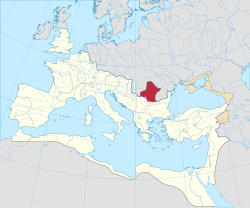Roman Dacia
|
Provincia Dacia η επαρχία της Δακίας |
|||||
| Province of the Roman Empire | |||||
|
|||||
| Roman province of Dacia (125 AD) | |||||
| Capital | Ulpia Traiana Sarmizegetusa | ||||
| Historical era | Classical Antiquity | ||||
| • | Annexed by Trajan | 107 | |||
| • | Withdrawal by Roman Emperor Aurelian | 271 | |||
| Today part of |
|
||||
Roman Dacia (also Dacia Traiana and Dacia Felix) was a province of the Roman Empire from 106 to 274–275 AD. Its territory consisted of eastern and south-eastern Transylvania, the Banat, and Oltenia (regions of modern Romania). It was from the very beginning organized as an imperial province and remained so throughout the Roman occupation. Historians' estimates of the population of Roman Dacia range from 650,000 to 1,200,000.
The conquest of Dacia was completed by Emperor Trajan (98–117) after two major campaigns against Decebalus' Dacian kingdom. The Romans did not occupy the entirety of the old Dacian kingdom, as the greater part of Moldavia, together with Maramureș and Crișana, was ruled by Free Dacians even after the Roman conquest. In 119, the Roman province was divided into two departments: Dacia Superior (Upper Dacia) and Dacia Inferior (Lower Dacia) (later named Dacia Malvensis). In 124 (or around 158), Dacia Superior was divided into two provinces: Dacia Apulensis and Dacia Porolissensis. During the Marcomannic Wars the military and judicial administration was unified under the command of one governor, with another two senators (the legati legionis) as his subordinates; the province was called tres Daciae (Three Dacias) or simply Dacia.
The Roman authorities undertook a massive and organized colonization of Dacia. New mines were opened and ore extraction intensified, while agriculture, stock breeding, and commerce flourished in the province. Dacia began to supply grain not only to the military personnel stationed in the province but also to the rest of the Balkan area. It became an urban province, with about 10 cities known, 8 of which held the highest rank of colonia, though the number of cities was fewer than in the region's other provinces. All the cities developed from old military camps. Ulpia Traiana Sarmizegetusa, the seat of the imperial procurator (finance officer) for all the three subdivisions was the financial, religious, and legislative center of the province. Apulum, where the military governor of the three subdivisions had his headquarters, was not simply the greatest city within the province, but one of the biggest across the whole Danubian frontier.
...
Wikipedia

